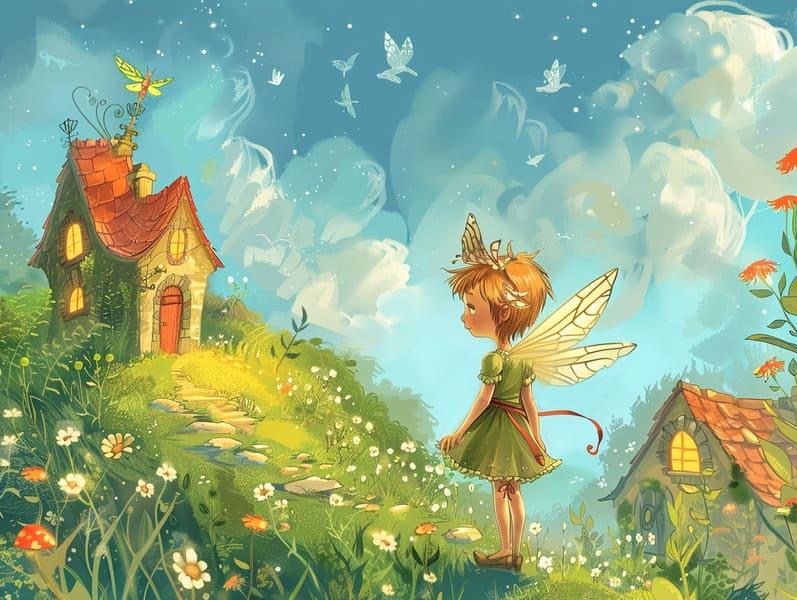
Historical fairy tales have deep roots. These stories have been shared from one generation to the next far before they were ever documented. They were born from a variety of civilizations, including Indigenous traditions. They were initially narrated among elders, often carrying themes and messages pertaining to the societal norms and beliefs of the time.
The famous Grimm duo, Jacob and Wilhelm, were among the first to compile many of these beloved tales. Their volume, "Grimm's Story Collection," included classics like "The True Bride," "The Story of Hansel and Gretel," and "Little Snow White," which have since become hallmarks in the world of beloved fairy tales. Similarly, Andersen's whimsical stories, such as "The Story of the Little Mermaid," and "The Duckling that Could," have captured hearts worldwide, cementing their place in the pantheon of treasured fairy tales.
Though they are centuries old, classic fairy tales remain as significant as ever, especially as children's bedtime stories. These delightful tales are now available in numerous formats, including vibrantly illustrated books, fantastical animations, and web-based fairy tales.
Their enduring popularity can be attributed to several enchanting factors:
Significant Morals: Timeless fairy tales often provide important moral lessons. Narratives like "The Tale of the Boy Who Cried Wolf" teach the virtue of being truthful, while "The Race of the Tortoise and the Hare" show the qualities of resolve and humbleness. These stories offer kids clear distinctions between virtue and vice, building their moral compass in a gentle yet impactful way.
Compassion and Knowledge: Classic fairy tales frequently present characters facing tests and troubles, prompting young listeners to empathize with their struggles and rally behind their triumphs. For instance, "Beauty's Beast" teaches us the merit of seeing beyond the surface to recognize the true nature of a soul, strengthening awareness and awareness.
Cultural Understanding: Many classic fairy tales are saturated in the cultural contexts from which they were born. Reading these stories can provide enlightening views into different ways of life, enhancing a sense of world respect and perception.
Imagination and Creativity: The extraordinary elements in ancient fairy tales—talking beasts—motivate children’s imaginative ideas. These narratives bring readers to supernatural realms, stimulating fantasy ideas and a sense of excitement that persists a lifetime.
Timeless fairy tales are not only enchanting but also pedagogical. They function as whimsical tools in cultivating various intellectual and emotional capacities in the young. When old fairy tales are read aloud, they strengthen language acquisition by showing new lexicon and detailed sentence structures. This practice also advances hearing perception and concentration, as young readers remain attentive, expectant to see what happens next.
Furthermore, conversing about the themes and characters of ancient fairy tales can nurture logical thinking and thought processes. The young learn to notice patterns, guess what will happen, and grasp cause and effect. These examinations also promote young ones speak out their thoughts and feelings, contributing to their emotional intelligence.
In today’s digital age, the presence of online storybooks has made these narratives more accessible than ever. Websites and programs offer vast collections of timeless fairy tales that can be experienced or listened through anytime, anywhere. Fairy tales spoken are particularly prevalent, sharing an engaging way for young ones to be a part of these entrancing tales. Audiobooks and voiced videos take characters and settings to life, often paired with charming soundtracks and music that enhance the narrative adventure.
The persistent attraction of old fairy tales lies in their ability to modify to present eras this site while preserving their basic principles. Contemporary reinterpretations of these tales often integrate more multicultural protagonists and modern settings, making them accessible to today’s audience. However, the essential messages of courage, generosity, and lawfulness remain unchanged, continuing to strike a chord with kids of all ages.
Fairy tales also offer a sense of protection and recognition. They render accessible a well-structured narrative with a apparent beginning, middle, and end, often finishing with the closure of conflicts and the triumph of goodness over badness. This steadiness can be encouraging for young ones, introducing a sense of solidity in an unstable world.
Traditional fairy tales continue to enchant and instruct new generations, maintaining their delight and importance in modern society. As kids' bedtime tales, they extend a perfect blend of charm and enlightenment, developing moral values, empathy, and creativity. The availability of free fairy tales online and the widespread nature of fairy tales narrated ensure that these old stories remain available to new generations.
By safeguarding and telling these fairy tales, we continue to recognize the rich tapestry of folklore and cultural heritage. Whether you are reading a vividly illustrated book, delving into a online library, or hearing an voice book, the grace of traditional fairy tales is always within reach. These fairy tales convey of the invariable strength of narratives and its ability to unify us across generations and cultures.
Regardless if you are exploring a vividly illustrated book, discovering a virtual collection, or listening on an sound book, the allure of old fairy tales is always within reach.
These tales demonstrate of the timeless impact of narratives and its ability to draw us together across epochs and places, creating a bond that captivates and teaches alike.
Comments on “The Story Behind Grimm's Fairy Tales and Its Ageless Fascination.”